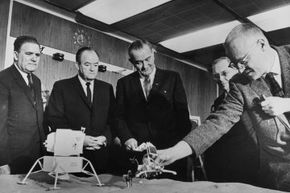At the apex of the space race, two superpowers duked it out for supremacy amongst the stars. In opposite corners, the USSR and United States worked feverishly to perfect their spacecraft and find a way to land men on the moon. Only one would emerge as the victor. And only one of them was led by a hard-nosed, politically-savvy man named James E. Webb, who harnessed the power of NASA and propelled the organization to (literally) never-before-seen heights.
Webb is best known as the second director of NASA. He oversaw the organization from 1961 until 1968, and is universally credited for some of NASA's most epic successes, including the Apollo program.
Advertisement
He was born in October 1906 and died at age 85 on March 29, 1992. In his eight-plus decades on Earth, Webb led a dynamic and forceful life in both corporate entities and government agencies.
It all started for Webb when he became a Marine Corps pilot in the early 1930s. After his stint in active duty, he earned his law degree from George Washington University.
He worked in public service, first becoming secretary for Rep. Edward W. Pou and then for O. Max Gardener. From 1936 to 1943, he worked at Sperry Gyroscope Corp., where he ascended to vice president before returning to the Marines for WWII.
Once the war subsided, he renewed his career in law and then served as Budget Bureau director and then undersecretary of state. His path then led to corporations involved in advanced technologies, such as Kerr-McGee Oil Industries and McDonnell Aircraft. Immediately before being appointed director of NASA, he worked for the Oak Ridge Institute of Nuclear Studies.
Webb was clearly a well-connected and ambitious man. Those traits were assets as he took the helm of NASA during the Kennedy administration. John F. Kennedy placed huge political and personal capital in the fledgling space program, using visions of space glory to capture the imaginations and support of millions of American citizens.
Webb then, was personally responsible for fulfilling JFK's grandest dreams. The president's directive to him? Put a man on the moon, and do it before anyone else. For Webb, it was the challenge of a lifetime.
Advertisement

